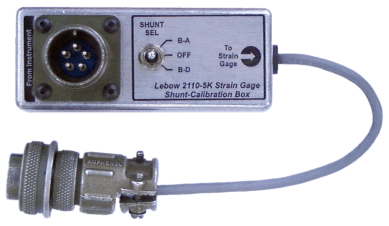
| Common apparatus |
|---|
| Hydraulic system |
| Electronic components |
| Data acquisition |
| EMG monitoring |
| NLID Tools |
| Troubleshooting |
| Materials |
| Supine apparatus |
|---|
| Assembly procedure |
| Safety Measures |
| Components |
| Servovalve |
| Actuator |
| Potentiometer |
| Pressure Filter |
| Torque transducer |
| Boot |
| Literature |
| Computing resources |
|---|
| CVS |
| Ethics |
|---|
| SDS / Inventory |
|---|
Torque Transducer - supine
 Lebow® Model 2110-5K Flanged reaction
torque sensor
Lebow® Model 2110-5K Flanged reaction
torque sensor
The torque transducer used to measure forces produced by the subjects is a general purpose reaction torque sensor. It is characterized by a high torsional stiffness (103941 Nm/Rad), large capacity (565 Nm), high resistance to bending moments, minimal friction error and low end sensitivity due to the absence of moving parts.
Interfacing
The transducer is interfaced to a strain gage conditioner module. The module needs to be calibrated according to the characteristics of the torque transducer. (See Operating Instructions.)
Calibration
The torque transducer + strain gage conditioner module is calibrated to yield 20 Nm/V. The sign convention is:
- Positive torque: Dorsiflexion
- Negative torque: Plantarflexion
Procedure
One means of calibrating the strain gage conditioner module + torque transducer combination is to attach the transducer to the module then shunt one leg of the strain gage bridge with a known precision calibration resistor. This produces an electrical signal at the bridge output that is equivalent to an applied torque. The calibration box shown below facilitates this task. The transducer is attached to the connector on the box and the cable emanating from the box is attached to the strain gage conditioner module. The box incorporates a shunt resistor and a switch that allows the user to selectively shunt legs B-A or B-D of the torque transducer bridge or remove the shunt altogether (OFF.)

The torque transducer came with a 60 kohm (±0.1%) calibration resistor. See the Operating Instructions for the equivalent torque load.
Unfortunately, the absolute torque generated by the ankle is usually lower than 100 Nm resulting in a transducer output voltage of less than 300 µV. This requires the strain gage conditioner module to have high gain; in practice the gain is set to be approximately 2000.
As a consequence of such high gain the above mentioned calibration resistor causes the strain gage conditioner module to saturate when the shunt is in place. Therefore, the shunt resistor in the calibration box is actually 120 kohms ±0.2%, twice the value of what the manufacturer provided, so that the shunt provides half the equivalent torque load specified in the transducer's calibration sheet.
Last Modifed: 2006-08-29 Ross Wagner